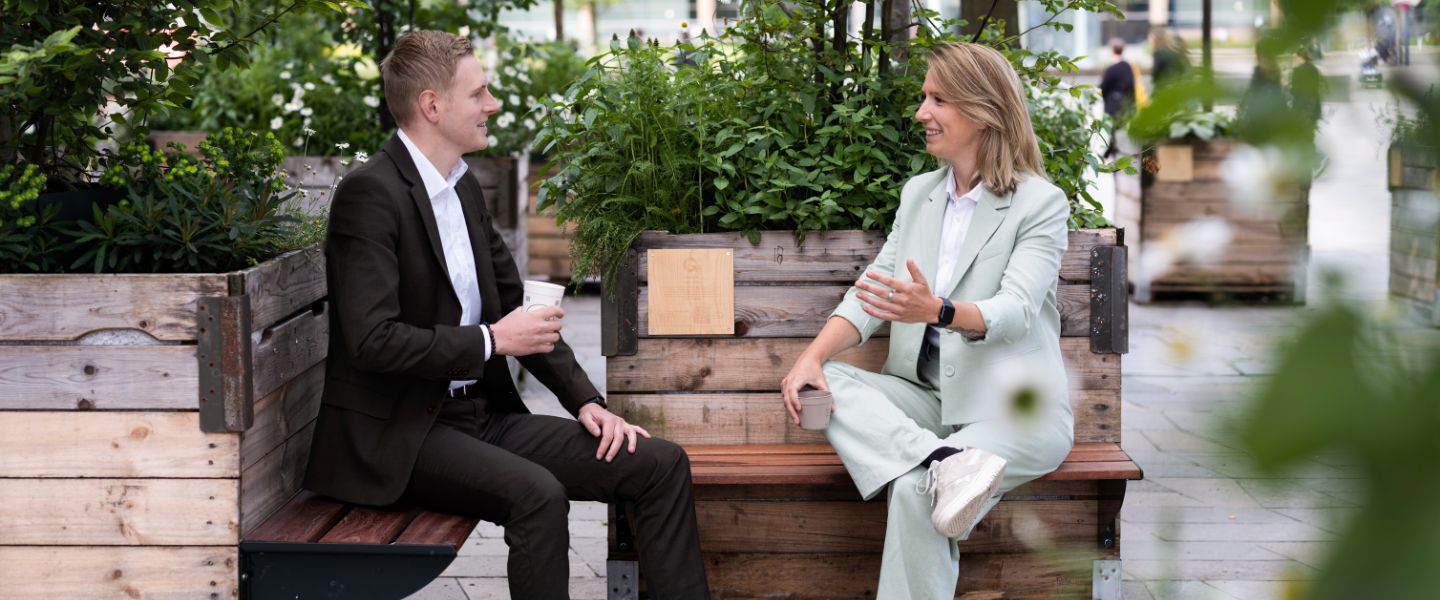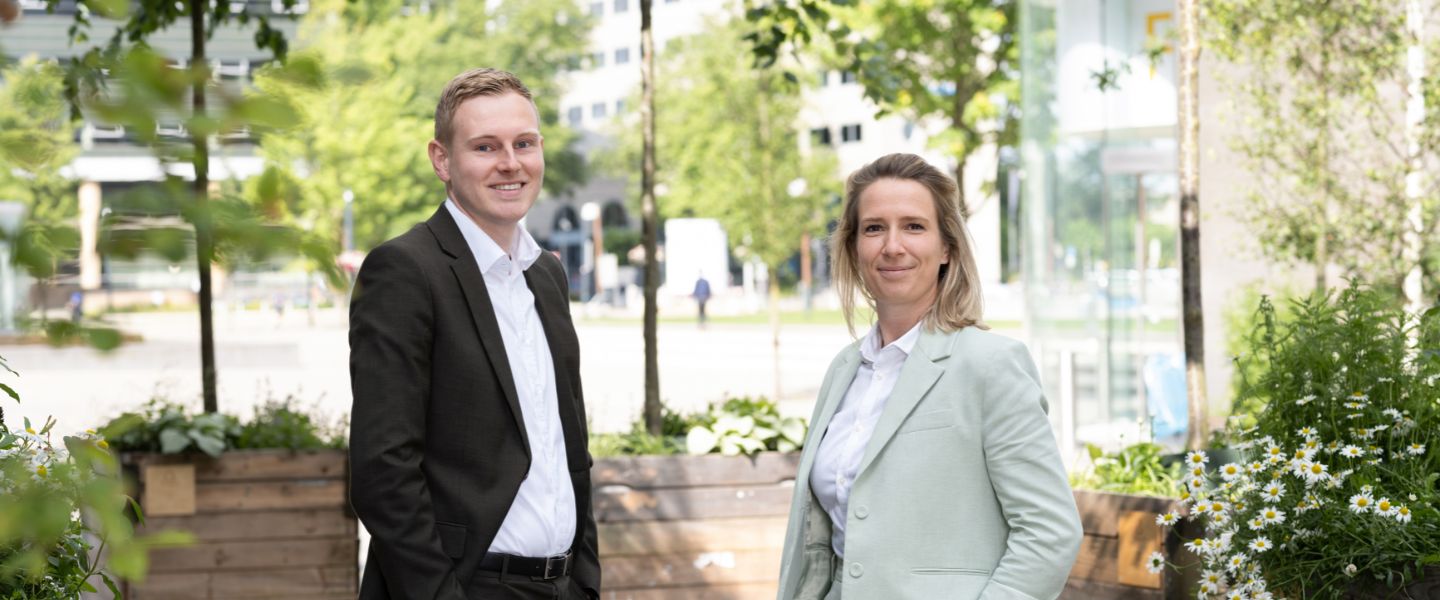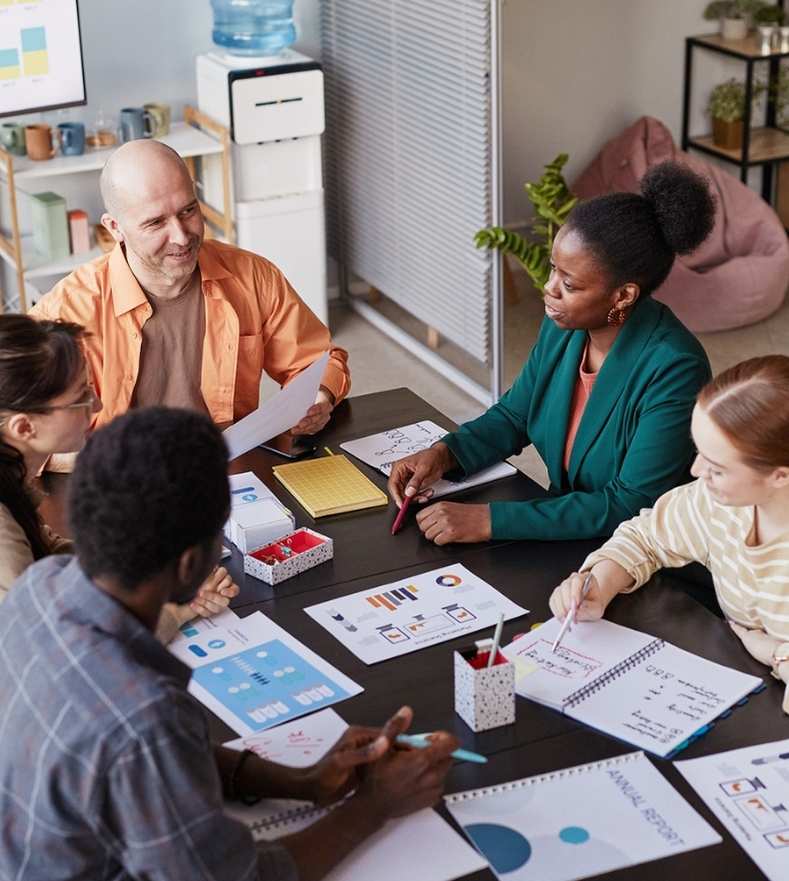What is the environmental impact of telecom products?
Grant Thornton's Impact House supports VodafoneZiggo in investigation.
VodafoneZiggo has the ambition to reduce the environmental impact of its product range. So, an essential first step is knowing how big that impact is, and where it hits. Really pinpointing it. For this, the telecom company relies on the expertise of Grant Thornton's Impact House. Sustainability manager Wietse Kuiken of VodafoneZiggo and Lara Plandsoen of Grant Thornton's Impact House discuss the investigation into the origin and environmental impact of four key product types.
VodafoneZiggo and Grant Thornton's Impact House have been working together on sustainability for five years. Lara Plandsoen says: "We are supporting VodafoneZiggo's sustainability team to make sustainability part of the telecom company's strategy." By 2025, VodafoneZiggo aims to halve its environmental impact in comparison to 2018, and to become carbon net zero by 2050. As a social goal, the company wants to make as many people as possible digitally skilled in order to close the digital divide.
"We are supporting VodafoneZiggo's sustainability team to make sustainability part of the telecom company's strategy." - Lara Plandsoen
Intrinsically motivated
This investigation into the origin and environmental impact of VodafoneZiggo's products is part of the collaboration and contributes to achieving the sustainability goals of the telecom company. "Our organisation is intrinsically motivated to know exactly what is in a product," explains sustainability manager Wietse Kuiken. "We want to know about the environmental consequences, and the risks involved, in terms of biodiversity and human rights. This project is the first step towards improving our products and reducing the environmental impact."
Wietse Kuiken also sees that corporate customers of the company are asking more and more explicitly about the origin of the materials used for a product. "For a long time, the telecom industry was all about two things: getting the connection right and getting it done at a competitive price. Fortunately, now a third topic is added to this list: sustainability."
Research into four products
Grant Thornton's Impact House and VodafoneZiggo selected four key products for their corporate market to investigate, products that are frequently purchased and used. They consisted of a SIM card, two kinds of modems and a fibre optic cable. These products have been subjected to a Life Cycle Assessment (LCA) with all the corresponding steps. "Firstly, we wanted to get a good insight into what that chain looks like," explains Lara Plandsoen of Grant Thornton's Impact House. That's a big challenge, because VodafoneZiggo uses thousands of suppliers for materials, components and products. "And that was the first thing I noticed," remembers Wietse Kuiken. "A single product can be very complex, and can sometimes consist of more than a hundred components and parts."
"The team of Grant Thornton's Impact House was in charge of carrying out the LCAs, but with the aim that the VodafoneZiggo team, too, can complete these types of projects independently in the long term." - Lara Plandsoen,
Cooperation based on ‘skills building’
Together with their teams, Kuiken and Plandsoen determined the origin of the different materials and the individual components of the four product types. That is a global exercise. "Sometimes you have to make assumptions," says Kuiken. "In that case, it is good to work with a specialised party that knows the way around all databases and has experience in creating LCAs."
Subsequently, using the measuring method of the GHG protocol, we can calculate the CO2 impact of a certain material. Plandsoen: "The team of Grant Thornton's Impact House was in charge of carrying out the LCAs, but with the aim that the VodafoneZiggo team, too, can complete these types of projects independently in the long term. Skills building is very much part of the collaboration with many of our clients, in order to ensure a lasting and ever greater impact."
Contact with suppliers
Where the origin of a material remained too unclear, suppliers were contacted. Grant Thornton's Impact House and VodafoneZiggo worked together on this. Approaching the chain partners requires sensitivity and is not easy, the two know from experience. Plandsoen understands this: "Some suppliers do not know exactly where the materials used come from. And maybe they do not want to know about that either. And certainly not about what working conditions the materials have been extracted under."
Plandsoen estimates that it will take at least another decade until full chain transparency is mainstream in business. "A shift in mindset is needed. For many organisations, it is still uncomfortable to share information about the origin of materials. From a competitive point of view, that is understandable in some cases. Meanwhile, VodafoneZiggo wants to find it out with the best intentions: together towards a better value chain."

It is not what you say, but the way that you say it
Gradually, the two noticed that the way the message was put across is vital. "If you convince suppliers of the added value, if you have good contacts and have gained the trust, you will get more done," Lara Plandsoen experienced. Kuiken adds: "Legislation and regulations also help to clarify the need for transparent information." Among other things, he refers to the reporting directive, the CSRD, which requires organisations to report transparently on their environmental impact. And the CSDDD, which requires companies to give insight into and act on social and environmental risks and negative impacts in their chain.
When is the product the most polluting
After most of the information had been clarified, VodafoneZiggo and Grant Thornton's Impact House investigated in which stage of a product's life cycle the environmental impact is greatest. For the modem, this was mainly due to its use, because the product needs power 24 hours a day and seven days a week. Almost 80% of the impact is in the use phase.
For fibre optic cables, the most environmental impact occurs during their installation. "That is only logical," according to the sustainability manager. "Digging is required to put the cables into the ground. That takes energy. If you know that, you can get on with it, and have a discussion with the parties installing the cables. You can ask them: ‘How are you going to make the installation of cables more sustainable in the coming years?’ He immediately stressed: "This is not just a task for the contractors; we regard this to be a joint responsibility. We invite them to our office and discuss how we can best tackle this together. These are some of the rather great results of this investigation."
"Design principles from the circular economy have now become part of our circular business policy. This is partly due to this project and our collaboration with Grant Thornton's Impact House." - Wietse Kuiken
Circular products
In addition, the two expect the results to contribute to further improvements of the telecom company's next generation of product designs. "Circular and with a minimal impact on the environment," Wietse Kuiken states ambitiously. "Can we use recycled plastic? And can we standardise screws and other connections so that products are easy to disassemble for reuse?" As a milestone, Kuiken reports: "Design principles from the circular economy have now become part of our circular business policy. This is partly due to this project and our collaboration with Grant Thornton's Impact House."
The practice round
Grant Thornton's Impact House has worked mainly with VodafoneZiggo's sustainability team on this project. "This was the practice round," says Plandsoen. "Ultimately, the outcomes need to be utilised and leveraged across the organisation. From the purchasing department to the commercial employees. It has to be business as usual."

Leading the way?
Is VodafoneZiggo at the forefront of the search for the origin and the environmental impact of products? Plandsoen sees that many companies are now working on it and are facing similar challenges. VodafoneZiggo is one of the ‘first movers’. "We are not necessarily aiming to be the very first," Kuiken insists. "Ultimately, we want to move forward as an entire telecom sector. Indeed, the industry needs to work together to make the whole chain more sustainable."
Continue together
The collaboration between VodafoneZiggo and Grant Thornton's Impact House goes on, after the first conclusions from the LCAs. Together, they continue to collect product information to further map both the social and environmental impact, so that VodafoneZiggo can take action to reduce and prevent negative impacts. The implementation of the CSRD and the CSDDD also requires attention. Kuiken: "We have always been as transparent as possible about our sustainability performance and dilemmas. With the advent of this new legislation, we can take further steps. We will do that together with Grant Thornton's Impact House as well."
Would you like to make your value chain transparent?
After years of negotiations, the Corporate Sustainability Due Diligence Directive (CSDDD) was adopted by the EU Member States on 24 May 2024. The CSDDD imposes obligations on companies to take responsibility for reducing and mitigating negative impacts and improving conditions for humans and the environment within the supply chain.
Related Insights
View more






